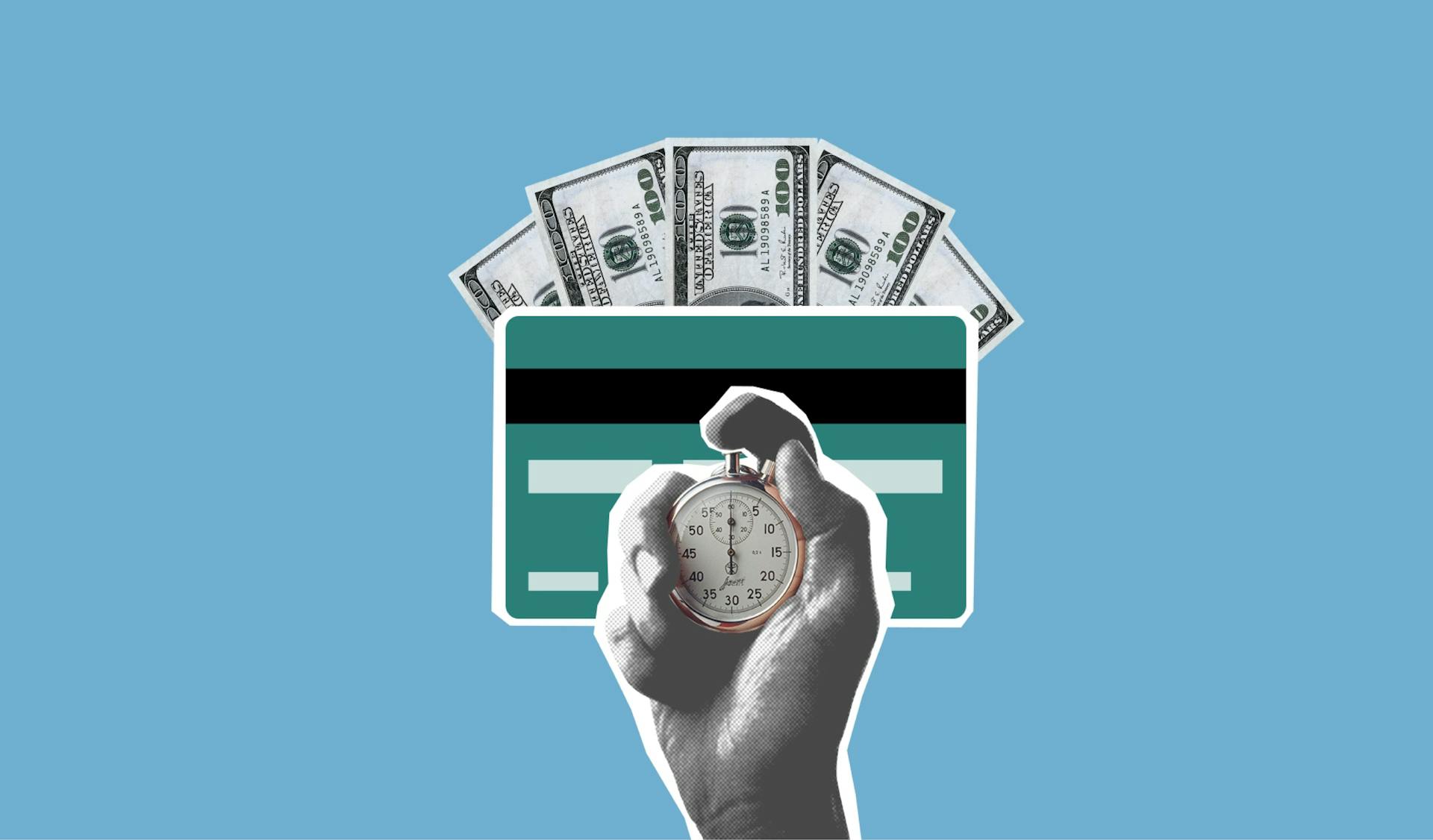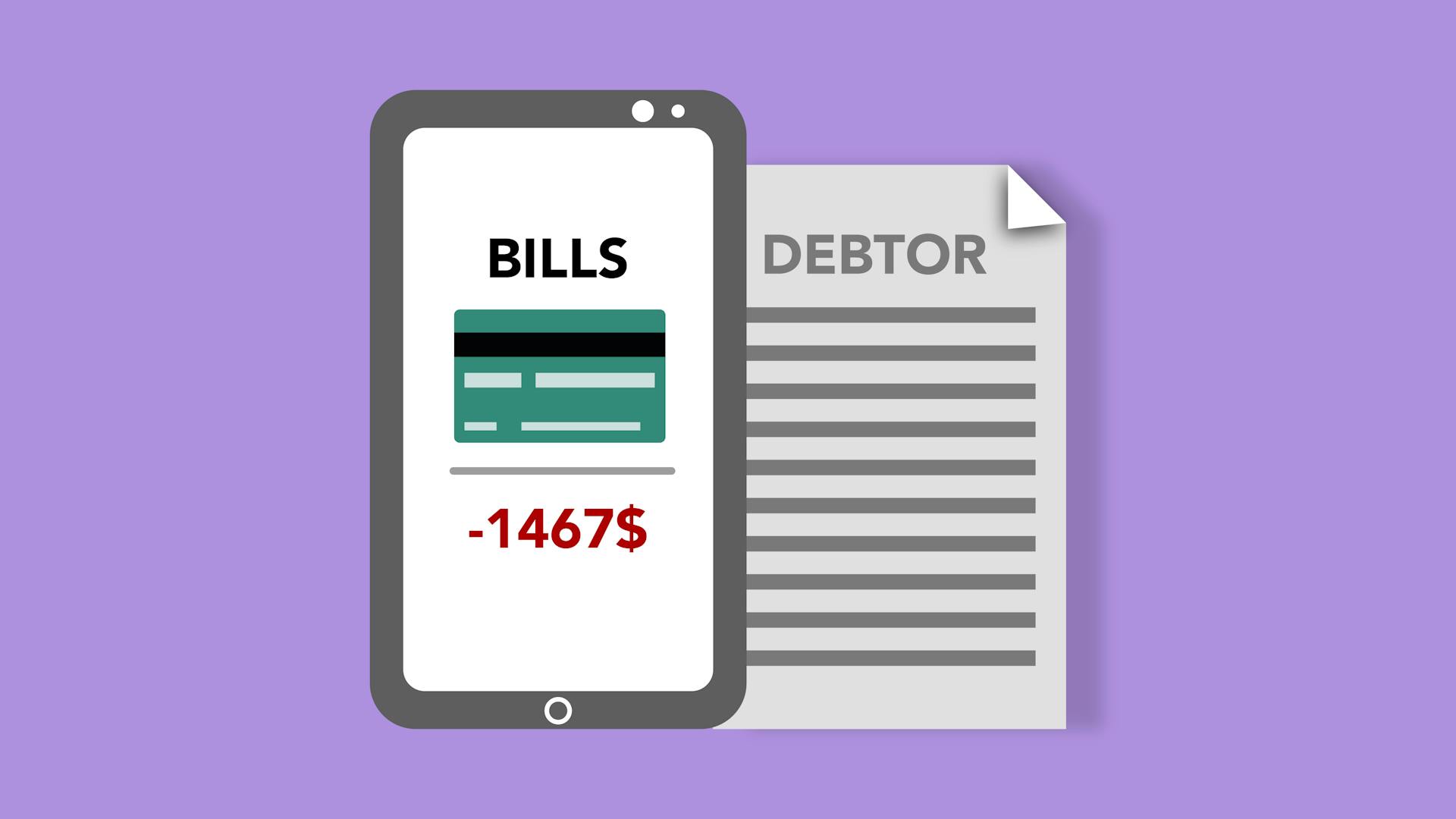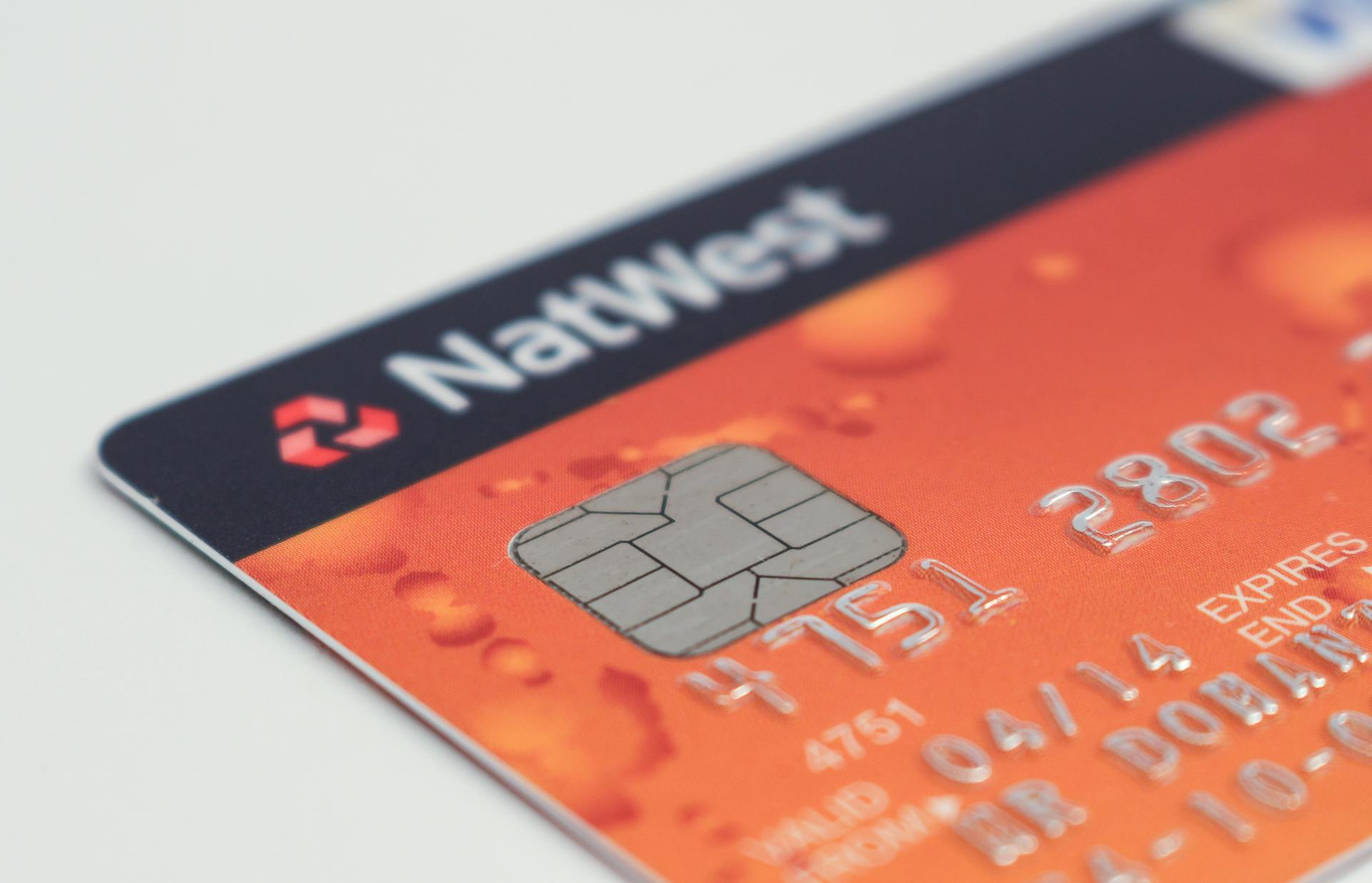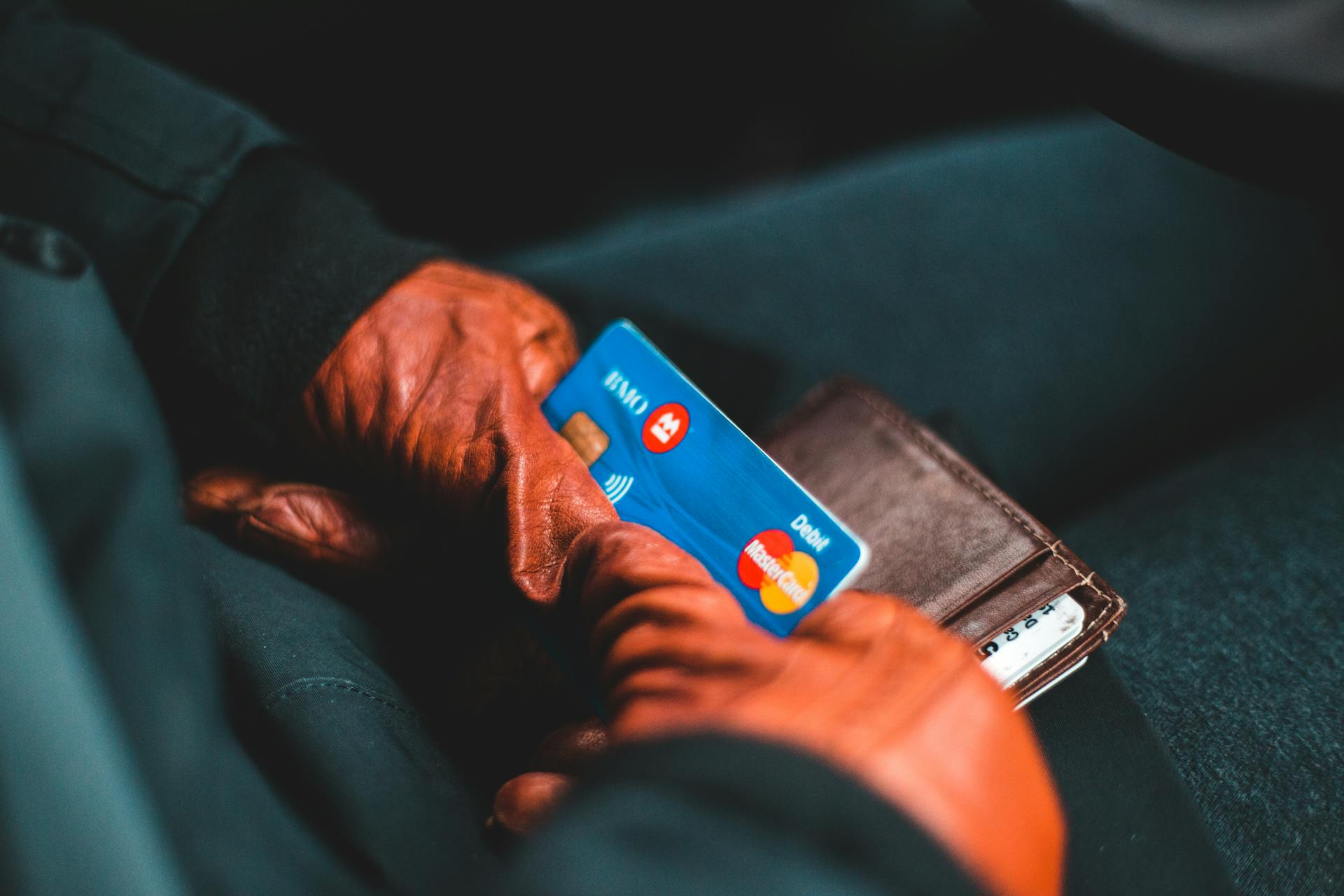
Using credit cards wisely can save you money and earn you rewards.
Pay your balance in full each month to avoid interest charges, which can be as high as 25% per year.
Set up automatic payments to ensure you never miss a payment, and consider setting a budget to track your expenses.
Choose a credit card with a 0% introductory APR to save money on interest for the first few months.
Suggestion: Can I Add More Money to My Secured Credit Card
Choosing the Right Credit Card
Choosing the right credit card is crucial to getting the most out of your money. Compare the representative annual percentage rate (APR) offered by different cards.
Your goals will determine which credit card is best for you. Do you want to make a big purchase or earn points for spending? Consider consolidating your credit card balances if you're struggling to pay off debt.
Fees and charges can add up quickly, so be sure to factor those into your decision. Don't be swayed by attractive rewards if the APR is too high.
On a similar theme: What Is My Interest Rate on My Discover Card
Managing Your Credit Card

Managing your credit card effectively requires discipline and a solid understanding of how interest rates and payments work. You can pay more than the minimum to reduce the amount of interest you pay, which can save you money in the long run.
If you're struggling to make payments, consider staggering your repayments throughout the month to chip away at the debt. This can help you make progress on paying off your credit card balance.
To avoid interest charges, pay your bill on time and in full. Many credit cards offer a grace period, which can be as long as 21 days, during which you won't be charged interest if you pay your balance in full.
Here are some key things to keep in mind when managing your credit card:
- Paying the minimum balance can lead to a longer payoff period and more interest paid overall.
- A single late payment can lead to a slippery slope of debt and low credit scores.
- Cash advances can be particularly hazardous, with immediate interest accrual and no grace period.
Make Payments on Time
Making payments on time is crucial when it comes to managing your credit card. Your payment history is important because it makes up 35% of your credit score.

A single late payment within a year of on-time payments can be a slippery slope that leads to debt and low credit scores. Late payments tend to spiral—cardholders get hit with late fees and interest charges that are hard to pay off, and then credit scores fall as debt rises.
You can avoid missing payments by setting up autopay or setting reminders on your phone. This will ensure that you never miss a credit card payment.
Most credit cards give cardholders a period of at least 21 days to pay off a balance without being charged interest—this is called a grace period. Some credit cards do not provide grace periods for purchases or other types of charges.
Always read the terms (including payment due dates and billing cycle length) before applying for a credit card. This will help you understand your payment obligations and avoid any potential pitfalls.
To make payments on time, consider the following:
- Set up autopay to automatically deduct your payment from your bank account.
- Set reminders on your phone to ensure you never miss a payment.
- Pay more than the minimum payment to reduce the amount of interest you pay.
Taking Cash Advances

Taking cash advances from your credit card is a bad idea. You start to accrue interest immediately, unlike regular credit card purchases.
The interest rate on cash advances can be high, and you'll often be charged an automatic fee that can run as high as 6% on the amount of the advance. This fee can quickly add up and make your debt even harder to pay off.
You'll also lose the opportunity to use that money for other important things, like paying off your debt or building an emergency fund. Credit card companies want you to take cash advances, but it's not in your best interest.
For your interest: Does National Debt Relief Close Your Credit Cards
Understanding Credit Card Interest
You usually need good credit to qualify for these cards, which can help make it less expensive to carry a balance.
Many low-interest cards come with a 0% introductory APR period, giving you time to pay off a large purchase without interest.

To build or rebuild credit, it's essential to keep balances low, as credit utilization is the second biggest factor affecting credit scores.
Experts recommend maintaining credit utilization under 30% to avoid negatively impacting your credit score.
The best way to keep balances low is to spend only what you can afford and pay every bill on time.
For more insights, see: Is It Worth It to Transfer Balances on Credit Cards
Maintaining a Healthy Credit Card Balance
Maintaining a healthy credit card balance is crucial for your financial well-being. To do this, it's essential to keep balances low, with experts recommending a credit utilization ratio under 30%. This means spending only what you can afford and paying every bill on time.
You can avoid high-interest rates by paying more than the minimum payment, which can help reduce the amount of interest you pay. In fact, paying just a little extra each month can make a significant difference in the long run. Consider setting up autopay or reminders on your phone to ensure you never miss a payment.
Related reading: Will Paying off My Credit Cards Improve My Score

Here's a breakdown of the benefits of paying more than the minimum:
- Reduces the amount of interest you pay
- Lowers your monthly payment amount
- Allows you to save money and invest in retirement
- Helps you avoid late fees and penalties
By following these tips, you can maintain a healthy credit card balance and avoid the pitfalls of high-interest rates and late fees.
Paying Minimum Balance
Paying only the minimum balance on your credit card can be tempting, but it's not the best approach. High-interest rates charged by credit card companies will add to your debt.
You'll be paying more in interest over time, making it harder to pay off the principal amount. Instead, aim to send the highest payment you can afford.
Reducing spending in other areas can help you focus on paying off the debt. You can use the saved money to accelerate debt payments, start an emergency fund, or invest in retirement.
The power of compound interest can work in your favor if you invest wisely. This means your money will grow over time, rather than just covering interest charges.
Check this out: Will a Prepaid Credit Card Build Credit
Keep Balances Low

Keeping balances low is crucial for maintaining a healthy credit card balance. Credit utilization is the second biggest factor affecting credit scores, and experts recommend cardholders maintain credit utilization under 30%.
To keep balances low, spend only what you can afford and pay every bill on time. This will help you avoid accumulating high-interest debt and negatively impacting your credit score.
Paying off the full balance each month is also a great way to keep balances low. Many credit cards offer a grace period, which is the period of time between the end of a billing cycle and when your bill is due. During a grace period, you may not be charged interest on your balance — as long as you pay it off by the due date.
Here are some tips to help you keep balances low:
- Set up autopay to ensure you never miss a payment.
- Pay more than the minimum payment to reduce the amount of interest you pay.
- Avoid maxing out your credit card credit line, as this can lead to over-limit fees and negatively impact your credit score.
Avoiding Common Mistakes
Don't ignore the terms and conditions of your credit card agreement - read them carefully before using the card to understand what's expected of you.
Banks and credit card companies supply these terms and conditions at the time of application and when the card is issued, so take the time to review them.
Ignoring debt can lead to a snowball effect of increasing interest and a lower credit score, making it harder to get back on track.
You can call the credit card company to renegotiate the terms of your agreement, and they may be willing to lower your interest rate, set up a payment plan, or even forgive some of your debt.
Keep calling back if the first representative doesn't work with you, as a different rep may be more willing to negotiate a better deal.
Consider reading: Can You Request a Lower Interest Rate on Credit Cards
Mistakes to Avoid
Not understanding the terms of the account agreement can lead to trouble down the line, so it's essential to read and comprehend the fine print before applying for a credit card.
Banks and credit cards supply the terms and conditions of specific cards at the time the application is completed and when the card is issued.
Carelessly making mistakes on your application can result in a rejected application, so double-check your information before submitting it.
The mistakes listed above are some of among those most frequently made by consumers.
Ignoring Your Debt

Ignoring your debt can make the problem worse as interest adds to the debt.
If you're feeling overwhelmed, you can call your card company to renegotiate the terms of your agreement. They may be willing to lower your interest rate, set up a payment plan, or even forgive some of your debt.
Missing a payment or two can trigger an increase in your interest rate, so it's best to communicate with your card company.
Keep calling back if your first call doesn't work, as a different customer service representative may be able to offer a better deal.
Ignoring debt can also lower your credit score and attract the attention of debt collectors, who may use unsavory tactics to collect the debt.
A unique perspective: Can You Pay Chase Credit Card at Bank
Credit Card Types and Features
There are several types of credit cards, including cash back, rewards, and balance transfer cards.
Cash back cards offer a percentage of your purchases back as a statement credit, with some cards offering up to 5% cash back on certain categories.
Expand your knowledge: Cash Advance from Credit Card to Bank Account

Rewards cards, on the other hand, offer points or miles that can be redeemed for travel, merchandise, or other rewards.
Balance transfer cards allow you to transfer high-interest debt from one card to another with a lower or 0% interest rate, but be aware that this offer usually comes with a transfer fee.
Curious to learn more? Check out: How to Account for Credit Card Rewards
Types of
There are several types of credit cards, each with its own set of features and benefits.
Cashback credit cards offer rewards in the form of cash or other rewards for purchases made with the card.
Rewards credit cards offer points or miles that can be redeemed for travel, merchandise, or other rewards.
Secured credit cards require a security deposit to open an account and are often used by people with poor or no credit.
Travel credit cards offer rewards and benefits specifically designed for travelers, such as airport lounge access and travel insurance.
On a similar theme: Credit Cards with Gift Card Rewards
Airline or Hotel Points and Miles
Airline or Hotel Points and Miles can be a great way to earn rewards, but it's essential to understand how they work. Some card issuers offer co-branded credit cards in partnership with major airlines and hotel programs.

These co-branded cards can be a good option if you travel frequently with a specific airline or stay at a particular hotel chain. For example, you can earn points with Delta SkyMiles or Hilton Honors.
However, the downside to earning points and miles associated with a specific airline or hotel is that they can only be used with the card's partnership airline or hotel. This can limit your redemption options.
Citi Simplicity
The Citi Simplicity card is a great option for those looking for a straightforward credit card with no annual fee. It offers a 0% Intro APR for 21 months on balance transfers and for 12 months on purchases.
One of the longest intro-APR offers for balance transfers is a key feature of the Citi Simplicity card. No annual fee is another perk, making it a cost-effective choice.
The card has no late fees, no penalty rate, and no annual fee, ever. This makes it a great option for those who tend to forget to pay their bills on time. The 0% Intro APR for 21 months on balance transfers and for 12 months on purchases is a significant benefit for those looking to save money on interest.
There is an intro balance transfer fee of 3% of each transfer (minimum $5) completed within the first 4 months of account opening. After that, the fee increases to 5% of each transfer (minimum $5). It's essential to keep track of this fee to avoid any surprise charges.
Curious to learn more? Check out: Should You Pay the Minimum on Credit Cards
Discover It Student Cash Back

The Discover It Student Cash Back card is a popular choice among students. It offers a unique welcome bonus that matches the cash back you earn for the first year.
You can earn cash back on everyday purchases, including 5% cash back on categories like grocery stores, restaurants, and gas stations. This bonus cash back is capped, and then you'll earn 1% back on all other purchases.
The card also offers an intro APR for purchases, which can be helpful for students who need to make big purchases. This APR is 0% for 6 months, then 17.24% - 26.24% variable.
One of the best features of this card is that it has no annual fee. This means you can use the card without worrying about extra costs.
To take advantage of the cash back categories, you'll need to activate them each quarter. But with a little planning, you can earn some great rewards.
A unique perspective: Student Credit Cards with No Credit
Here are some key features of the Discover It Student Cash Back card:
- Unique welcome bonus matches the cash back you earn for the first year
- No annual fee
- Intro APR for purchases (0% for 6 months, then 17.24% - 26.24% variable)
- Earn 5% cash back on everyday purchases in quarterly categories
- Earn unlimited 1% cash back on all other purchases
- No credit score required to apply
Credit Card Costs and Fees
Credit card costs can add up quickly, but you can avoid most of them with responsible use. You can avoid interest payments altogether by paying your balance in full every month.
Annual fees can range from $20 to hundreds of dollars, but it's worth paying if the card offers rewards and perks that make up for the cost. In most cases, you shouldn't pay a fee just for having the card.
Late payment fees are limited by federal regulations, capping first-time late fees at $27 and second late payments within six months at $38. Late fees also can't cost more than the minimum payment due.
Balance transfer fees typically range from 3% to 5% of the amount of debt transferred, with some cards waiving the fee if you transfer debt within a certain time frame.
A unique perspective: How to Avoid Interest on Credit Cards
Balance Transfer Fee

A balance transfer fee is a cost you'll pay when you move debt from one credit card to another. It's usually a percentage of the amount transferred, ranging from 3% to 5%.
Some balance transfer credit cards charge an intro balance transfer fee, which is a one-time fee, while others charge a fee on future balance transfers. Check the terms to see what applies to you.
The good news is that some cards waive the balance transfer fee when you transfer debt within a certain time frame. This can save you money upfront.
Make sure you understand the balance transfer fee you'll pay before making a transfer, as it can add up quickly. It's also essential to consider the length of the interest-free period offered by the new card.
You might enjoy: Expiration Dates on Credit Cards
Costs of Carrying
Credit cards can come with costs, but you can avoid most of them with responsible use. They include interest payments, annual fees, late payment fees, balance transfer fees, and foreign transaction fees.
See what others are reading: Chase Credit Card Fees

Interest payments can add up quickly, especially if you don't pay your balance in full every month. Federal regulations limit how much late fees can be, capping first-time late fees at $27 and second late payments within six months at $38.
Annual fees can range from around $20 to hundreds of dollars, but they might be worth paying if the card gives you rewards and perks that make up for the cost. Balance transfer fees are generally 3% to 5% of the amount of debt transferred, but some cards waive the fee when you transfer debt within a certain time frame.
Most cards add a surcharge of 1% to 3% on transactions made with non-U.S. merchants, but travel credit cards generally don't charge these fees. You can avoid most of these costs by paying your balance in full every month and being mindful of your spending.
Consider reading: Does Paying Credit Cards Early Help
Frequently Asked Questions
What is the 2 3 4 rule for credit cards?
The 2/3/4 rule is a Bank of America credit card limit that restricts new card approvals to two within 30 days, three within 12 months, and four within 24 months. This rule applies specifically to Bank of America credit cards, not all credit cards.
What is the 50 30 20 rule for credit cards?
The 50 30 20 rule for managing credit card expenses suggests allocating 50% towards necessary costs, 30% towards discretionary spending, and 20% towards savings or debt repayment. By following this rule, you can maintain a balanced financial approach and make the most of your credit card spending.
Sources
- https://www.hsbc.co.uk/credit-cards/tips-for-using-your-credit-card/
- https://www.nerdwallet.com/article/credit-cards/credit-cards-101
- https://www.cnbc.com/select/credit-card-tips-for-new-users/
- https://www.investopedia.com/articles/pf/07/credit-card-donts.asp
- https://www.forbes.com/advisor/credit-cards/how-to-use-a-credit-card/
Featured Images: pexels.com


